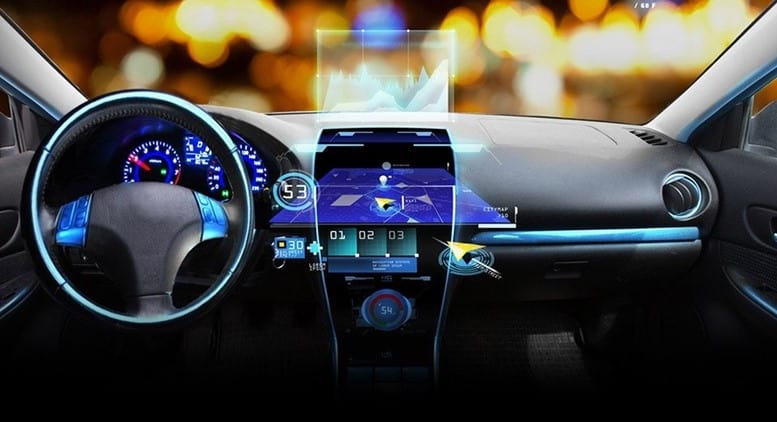'When it comes to sharing data, there isn’t a lot of that going on right now due to the relative immaturity of data collection and analytics in the industry as a whole. But Airbiquity expects that to change going forward with the introduction of OTA systems, expanded managed ecosystems, and associated monetization efforts.'
We’ve seen big data infiltrate countless industries—from mobile to enterprise software, and healthcare—you name it, it’s been disrupted. While the writing’s been on the wall as connected vehicles becoming increasingly complex – boasting more lines of bode than a fighter jet – by 2018, data will take the front seat on the automotive industry’s list of priorities. In fact, in the US alone 260 million cars will produce about 5,800 exabytes of data daily, enough to fill 1.4 million Amazon tractor-trailer mobile data centers – or a convoy 11,000 miles long, according to Barclays. As we creep closer to an autonomous future, real-time data collection, management and analytics will be at the core crux of vehicle advancements in 2018.
Scott Frank, Vice President of Marketing at Airbiquity discusses with The Fast Mode the way data will impact the automotive industry.
The Fast Mode: How big of a market opportunity is big data in the automotive industry?
 Scott Frank: Current projections expect that the growth of car data and mobility could reach more than $1.5 trillion by 2030, according to McKinsey. With such staggering potential of new features, capabilities, and monetization opportunities for new ecosystem partners, there’s no doubt that all eyes will be on big data within the automotive industry – a conversation that is sure to stay top of mind in 2018 and beyond. As data initiatives reach the top of every automakers list, we’ll begin to see how automakers and ecosystem partners leverage the data to make it actionable impacting both the automaker and driver experience alike. Whether monitoring vehicle performance, providing views into driver behavior, enabling consumer insurance pricing based on actual driving performance and habits, or leveraging data for predictive analytics to drive new services, one thing is certain: data will be moving into the front seat in the automotive industry.
Scott Frank: Current projections expect that the growth of car data and mobility could reach more than $1.5 trillion by 2030, according to McKinsey. With such staggering potential of new features, capabilities, and monetization opportunities for new ecosystem partners, there’s no doubt that all eyes will be on big data within the automotive industry – a conversation that is sure to stay top of mind in 2018 and beyond. As data initiatives reach the top of every automakers list, we’ll begin to see how automakers and ecosystem partners leverage the data to make it actionable impacting both the automaker and driver experience alike. Whether monitoring vehicle performance, providing views into driver behavior, enabling consumer insurance pricing based on actual driving performance and habits, or leveraging data for predictive analytics to drive new services, one thing is certain: data will be moving into the front seat in the automotive industry.
The Fast Mode: Until now, data hasn’t been collected, managed or analyzed from the vehicle environment, which begs the question: who will own the data?
Scott Frank: For background, the two major categories of data that will be collected are vehicle operational data and driving behavior data, and the specific data points that will be collected will vary based on the business and program requirements of the automaker or mobility service provider deploying the program. There will also be an increasing amount of data points—and data volume— that can be exported off a vehicle due to continual advancements in on-board technology like cameras and sensors. Most automakers and mobility service providers are moving to collect as much data as possible going forward to maximize their data and analytic opportunities which span product or service support, customer service, business operations, and monetization. When it comes to sharing data, there isn’t a lot of that going on right now due to the relative immaturity of data collection and analytics in the industry as a whole. But Airbiquity expects that to change going forward with the introduction of OTA systems, expanded managed ecosystems, and associated monetization efforts.
Having said this, the industry will need to begin differentiating data that belongs to the automaker or mobility service provider from data that belongs to vehicle drivers and passengers. At a macro level, we think a likely scenario is vehicle operational data (system and component level) will be owned by the automakers and service providers who can leverage it to understand the vehicle condition, ensure its operating as intended, detect cybersecurity breaches, and conduct vehicle recalls, maintenance, and service. Driving behavior data (location, speed, braking, etc.), if a human is driving, will be owned by consumers that will be able to opt-in or opt-out to sharing their data at any point in time. We also expect that consumers will increasingly look for something of value in return for sharing their personal data, so the onus will be on the automakers and service providers to build that into their programs and communicate it clearly.
The Fast Mode: How will vehicle data and management help enable the Internet of Things (IoT)?
Scott Frank: We’re currently in an early phase of the IoT where devices are getting connected to the internet, each other, and services in the cloud. In the most basic sense, the smartphone was one of the first “connected devices” and now we have items like wearable watches, smart digital voice assistants, connected fridges, doggie cams, and connected vehicles. But as we enter a new wave of the IoT—where all of our connected devices will become more intelligent by communicating with one another—the foundation of the communication will be instantaneous 24/7 collection and analysis of data in real-time. This is where vehicle data management will greatly impact the return-on-investment (ROI) for automakers and role connected vehicles will play in an expanding world of IoT. For example, our cars will be able to communicate with sensors on each block to inform traffic flows, sensors on our cars will map out where potholes are in the road and communicate with other cars to avoid them and city public works for repair, and cars will inform drivers of traffic jams on preferred routes while also offering up alternative commute options. The common thread? Collecting, analyzing, and sharing data.
The Fast Mode: How will 4G/5G networks enable new opportunities for vehicle data?
Scott Frank: In general, the higher the connectivity bandwidth the faster the transmission of OTA data payloads (and software updates) between the cloud and the vehicle. Today’s 4G/LTE bandwidth is adequate for most if not all OTA data payloads planned for the next 1-5 years. Higher bandwidth options like 5G will be increasingly preferred 6-10 years out for the realization of differentiated data and analytics reliant user experiences associated with vehicle features and performance, on-board infotainment and driving applications, and off-board services from extended ecosystems (both monetized and non-monetized).




















